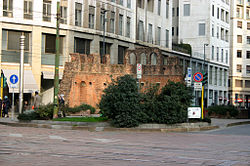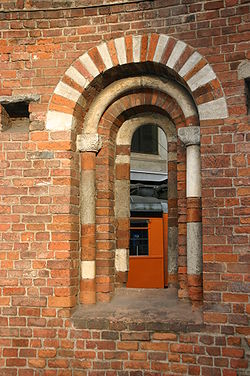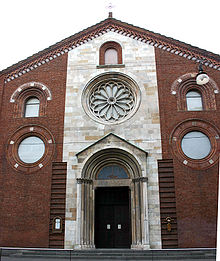- San Giovanni in Conca
-
Crypt of Saint John in Conca
(Cripta di San Giovanni in Conca)
Current remains of San Giovanni in Conca visible from surface.
Basic information Location Milan, Italy Geographic coordinates Coordinates: 45°27′40″N 9°11′20″E / 45.461112°N 9.188810°E Affiliation Roman Catholic Province Milan Architectural description Architectural type Crypt Architectural style Romanesque San Giovanni in Conca is a crypt of a former basilica church in Milan, northern Italy. It is now located in the centre of Piazza Missori.
History
The basilica of San Giovanni in Conca dates from the 4th century AD, and was located in a residential quarter of the ancient city. Remains of the mosaic pavement of this original edifice are now in the Arhcaeological Museum of Milan.
The church was rebuilt in the 11th century, but was destroyed by Frederick Barbarossa's troops in 1162. It was again reconstructed in the 13th century and later became the private chapel of the Visconti rulers of Milan. Bernabò Visconti had it connected to his new grandiose palace through a super-elevated walk, and was buried here in a monument by Bonino da Campione which is now in the Sforzesco Castle together with that of his consort, Regina della Scala.
In 1531 Duke Francesco II Sforza donated it to the Carmelites, who erected a campanile which was utilized as astronomical observatory in the 19th century. The church was deconsecrated by the Austrians and closed by the French in the late 18th century.
In 1879 the church was shortened to allow the construction of the current Via Mazzini; in the occasion, the Gothic façade was attached to the apse. San Giovanni in Conca was then sold to the Waldensians who, when the church was demolished (1949), rebuilt the façade on their new church in Via Francesco Sforza. Works of demolition were however halted just before their end, leaving only the crypt and remains of the apse.
Remains
San Giovanni in Conca ruins include the only extant example of Romanesque crypt in Milan. It houses archaeological findings which illustrates the church's history.
Over the crypt are remains of the apse walls, with a single mullioned window and blind arches typical of the Milanese Romanesque.
Artworks from the church which are now in the Sforzesco Castle include, apart the two aforementioned funerary monuments, two figures from an Annunciation (11th century), some Romanesque capitals and frescoes from the 14th century.
References
- Page about the church's history (Italian)
Categories:- Churches in Milan
- 14th-century architecture
- 18th-century disestablishments
- 4th-century church buildings
- Romanesque architecture in Lombardy
Wikimedia Foundation. 2010.


